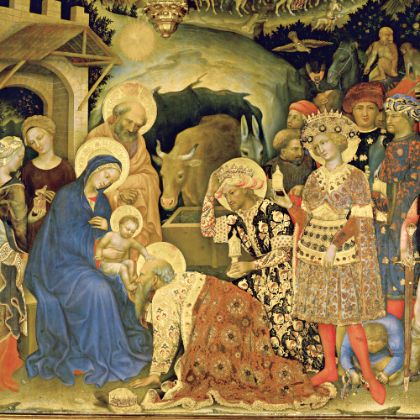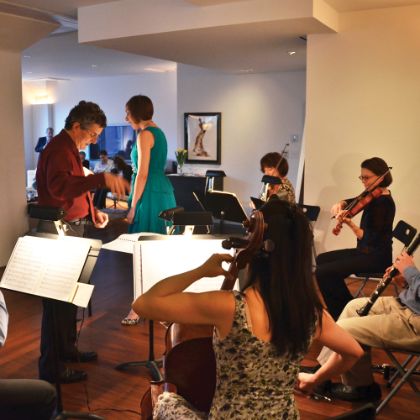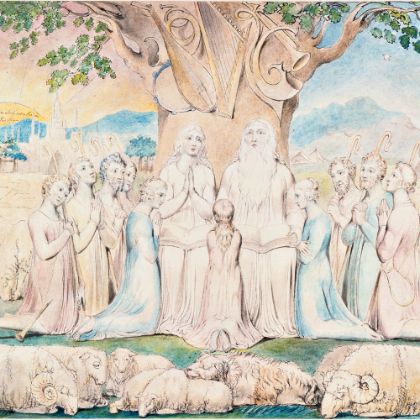Stravinsky’s Jeu de cartes offers a vision of a fading and faded world.
By Daniel Felsenfeld
Igor Stravinsky may well be the most documented composer this side of Richard Wagner. Not only are shelves of books available both by and about him, but there are also films — both fictive (one focusing on his affair with Coco Chanel) and documentary (the indispensable Once at a Border) — biographical novels, festivals and endless recordings. His place in history is assured by a wide panoply of imitators, advocates and keepers of the flame. And this is by no means a posthumous phenomenon: in his day, Stravinsky rubbed elbows with royalty from Hollywood to New York. He knew Aldous Huxley and Christopher Isherwood but also Charlie Chaplin; he knew Dylan Thomas, W.H. Auden and T.S. Eliot, but also Douglas Fairbanks. His circle was wide, his fame — and not just “for a composer” — something that will probably never come again.
For this legacy we have Robert Craft to thank, the man whose devotion to the master defines the word amanuensis [one employed to write from dictation or to copy manuscript –Ed.]. For decades Craft was Stravinsky’s companion, trusted musical collaborator, friend, mouthpiece and defender, and in the four decades since Stravinsky’s death, he continues to do all that can be done for the man, his myth and his music. In Once at a Border, Craft takes us on a tour of Stravinsky’s composing “kit,” a little bag he toted from place to place and stuffed with essentials — favorite pencils and erasers, a rolling ink stylus with which one could furnish blank paper with staves, and, never to be omitted, a common deck of playing cards.
Jeu de cartes, or The Card Game, is a three-movement ballet from 1935, Stravinsky’s first commission from Lincoln Kirstein and an ex post facto collaboration with George Balanchine. As was often the case with Stravinsky, he wrote the exact piece he wanted and then found it a good home. “More than a decade before composing Jeu de cartes,” he said, “I was aware of an idea for a ballet with playing-card costumes and a green-baize gaming-table backdrop.... The score was not designed for any particular audience, and in fact it was nearly completed before I received the commission.” As an experienced composer for ballet, Stravinsky mapped out every moment of the piece, making his own scenario after Jean Cocteau turned down an offer to work together. The scenario involves a complex and specific interaction of playing cards presided over by the joker — “an element of chance,” according to the composer, “and an escape.” It is as if Petrushka, the titular hero-clown from an earlier Stravinsky ballet, is reconstituted in a less folksy, more urbane setting, with plenty of havoc to wreak. At one point he assumes the role of a fourth ace in order to rout three queens, only to be himself bested later by a trio of flushes.
‘Jeu de cartes is a piece of much-needed (and very well-planned) buffoonery, the comic moment that only serves to offset the fear of the larger tragedy, making it more real.’
The work itself is divided into three “deals,” each of which opens with the exact same fanfare, a musical stunt effective in ballet but less so in more rigorous symphonic forms; though he was the most rigorous of composers, Stravinsky cottoned early to dance and only later came to write his symphonies and sonatas. One can think of the repeated fanfare as the shuffling of the cards, or, in the composer’s words, “the voice of the master of ceremonies at that first casino” — the casino being one Stravinsky remembered from an early family vacation to a Baden-Baden spa, where games were the order of the day. At the beginning of each hand, the dealer would make an announcement, “the timbre, character and pomposity” of which are musically represented at the beginning of each movement. Like all games of chance, each hand begins with a level playing field.
In Jeu de cartes, unlike any work before or after, Stravinsky indulged in a riot of musical quotations, tributes to music “that might be imagined drifting from the Municipal Opera, or the concert by the Kursaal Band” in the casino of his childhood. There are scraps of music by Johann Strauss, Ravel, Beethoven, Debussy, and ultimately, in a piece of hysterical agon with the past, an asymmetrical but fully recognizable reading of Rossini’s overture to The Barber of Seville. This was hardly the first work in which Stravinsky had annexed another composer’s work — Pulcinella traded on the music of Pergolesi — but it was the first in which he spanned such a chasm of “other” for comic effect, or as part, let us say, of an involved musical gambit. This has raised an academic eyebrow more than once, eliciting the accusation of “postmodernism,” but there is more to Stravinsky’s use of others’ music than simple out-of-context, high–low joissance. Rossini aside, the quotes are buried, a trove for musicologists rather than a sleek, recognizable surface. Their more important function is to allow Stravinsky to leap from place to place, snickering along with his dancing cards. The quotes are an in-joke, yes, but they can also be heard as a vision of a faded and fading world. This is the work of a composer looking around, up and out — to the wider world of music — as well as in and back — to his vanished childhood, his distant mother country and, not to put it too dramatically, into a void from which he desperately needed diversion. One plays games of chance as distractions — they pass time, they invite conversation, they require temporary laser focus on a low-stakes event. Looked at in this fashion, and like any game worth playing, Jeu de cartes is a dead-serious set of concealed squibs that serve to mask the truth of the situation.
Most composers’ music is difficult to describe in prose, but Stravinsky’s is especially so. With few exceptions, it tends to lack The Big Memorable Tune; his melodies are supple but often angular, arriving in unexpected places or built on well-plotted rhythmic inconsistencies (what Leonard Bernstein called “Igor’s asymmetry racket”). Events happen in an odd order, on slightly off beats; the toe is unable to tap to the erratic pulse. And what makes his music so infuriatingly cunning is his disregard for any of the received notions of form, which were all built — whether the form was ballet, sonata or symphony — with physical movement in mind. “Stravinsky’s ‘and then... and then... and then’ is, of course, a controlled and choreographed ‘and then... and then... and then,’” writes composer Louis Andriessen in his indispensable The Apollonian Clockwork.
The First Deal ranges from the fanfare through an almost drunken “waltz” to a Nutcracker–like dash and closes with sleepy winds. The Second commences, fanfare aside, with lush strings and then crashes into what feels like a chattering “oom-pah-pah” straight out of Verdi, culminating in a cheeky flourish. Stravinsky builds the Third Deal to a manic intensity reminiscent of the more high-decibel moments of Le sacre du printemps, only to collapse this momentum hysterically into the Rossini quote, after which he constructs a series of (if not variations on) quirky reconstructions of that unlikely source material. He ends the movement, and the work, with a deception that Brahms would have envied: What seems like chapter-and-verse return pivots into darkness and the fanfare is turned on its proverbial ear, a splat more than a crash. These wide moves within movements are built to match the complicated action of the ballet, but as a piece of pure concert music, the fleet nature of the moment-to-moment musical argument is certainly enjoyable, even funny.
Le sacre du printemps retains its historical place within Stravinsky’s oeuvre and the musical world-at-large not because of its storied premiere (though that never hurts) but because of its innovative musical construction, wherein small sonic units both atomized and organized run into one another. This chaos of intricate, detailed “and then... and then... and then” was inspired by the delicate mobiles of Alexander Calder. With Jeu de cartes, Stravinsky employed the universal, dime-store equivalent of the Calder mobiles: playing cards, available everywhere. When Balanchine set about choreographing the work, Stravinsky intervened only on behalf of the costumes. Based on tarot cards, they were “handsome in themselves,” the composer said later, “but too sumptuous for my ‘brittle’ and ‘heartless’ music.” He sent the designer to the corner store.
The accusation of heartlessness plagued Stravinsky in this middle period of his life (handily referred to as his “neo-classical” phase, though it could be more aptly labeled his “cosmopolitan” or “urbane” or even “American” phase). He may have taken too much to heart his artistically simpatico friend T.S. Eliot’s aperçu that poetry is not an indulgence of, but rather an escape from, emotion. In Jeu de cartes, it would be easy to mistake the exactitude of the rhythmic clip and the absence of longueurs (in the form of gradual orchestral crescendos or soaring strings) as a kind of coldness. But to hear the music as the work of sexless, blunt reason is to do it a disservice, even miss the point. Like Eliot, Jeu de cartes can be read on several levels: the immediate; the deeper dig; and the terrified, all-too-knowing divertimento — or Eliot’s “objective correlative,” wherein two seemingly innocent things placed against each other serve to capture a horror too great to speak. Seen this way, many of Stravinsky’s “neo-classical” works stand as more substantial and complicated than those of his prior “Russian” stage or the period of atonal experimentalism to come. Jeu de cartes is a piece of much-needed (and very well-planned) buffoonery, the comic moment that only serves to offset the fear of the larger tragedy, making it more real. It is a game to distract the mind and the world from a gathering storm.
“The fortunes of my music in the Third Reich,” said Stravinsky, “are unaccountable.” It was in 1934 that Richard Strauss, of all people, came to the aid of the composer’s unjustly (and intentionally) blighted reputation. But this could not stop the wheels of history, and the Russian found himself and his music front and center at Hitler’s 1938 Entartete Musik exhibit along with other “degenerate” composers like Schoenberg, Berg, Hindemith, Weill and Krenek. Stravinsky, not exactly a philo-Semite, was rumored to be Jewish, and in corrupt theocratic regimes, as we continue to learn, a raised question can do damage with or without an answer, regardless of the truth.
For those who think it unwise to inspect context, Jeu de cartes might be an underappreciated work because of its outright simplicity, its seeming lack of seriousness, and the common yet somehow obscure nature of its “plot.” Perhaps that is why it falls short, in performance, against many of the same composer’s more recognizable pieces. As for those “notes only” thinkers who believe that the score tells the whole story, it might be conceded that on those terms, they are right: it is a puff piece. But with a glimpse into the time, place and person, this puff piece’s purpose and depth become apparent. At the gravest historical moments, light comedy can explain more than the deepest tragedy or the most incisive manifesto can; Jeu de cartes allows a giggle when a giggle ought not to be.

-

From Christemasse to Carole
The birth of Christmas in medieval England
Read More
By David Vernier -

The Next (Not-So-)Big Thing
New chamber orchestras are popping up all over America.
Read More
By Colin Eatock -

A Father's Lament
Finding solace in the sound of authentic sorrow
Read More
By Rev. Jake Bohstedt Morrill